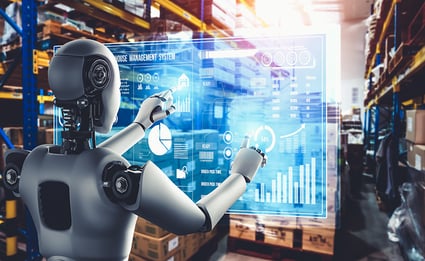The Best Supply Chain Recipe for Winning With Inflation
Keith LaBotz - January 13, 2022

Find the Best Solutions to Protect Supply Chains from Inflation
Today’s feature is a fire-roasted global supply chain garnished with inflation. Are you hungry for a solution?
According to KPMG, US grocery prices ascended to their highest inflation in 31 years, increasing an average of 22%. Inflation is on everyone’s mind, and it will undoubtedly be a topic for supply chains this year.
88% of global executives chose inflation from a menu for supply chain concerns in a recent study by Accenture. The sentiment is echoed in a McKinsey survey last month, with 35% of European and 52% of North American business leaders ranking inflation as an economic risk.
No one knows where inflation is headed, but we know supply chains must become more efficient. Given the digitalization efforts already underway in many companies, there’s little room for inflation solutions that detract from current efforts.
Some cost-saving opportunities are more promising than others. You just have to know where to look, and that’s what this post will help you do.
Let’s start looking.
Look at Controlling Cost
Supply chains can’t control inflation, but they can control costs. There’s not much to be gained from trying to understand inflation’s causes or cure - even central banks cannot agree on it. Instead, concentrate efforts on increasing efficiency to reduce costs.
Look for Automation Opportunities
Automation minimizes labor expenses, errors, disruptions, and resource consumption.
The savings can be significant and repetitive tasks, like those in production and warehousing, are good candidates for robotics, machinery, and AI.
There are levels of automation for every process, but digitalization should always be the precursor. Consider warehouse automation.
- Material handling can be automated with machinery like conveyors and forklifts without IT resources.
- The next level of automation is workflow. Order picking can be performed using an RF guided picking system and container serialization system. These systems might require IT support for providing batch files or API integration with the WMS.
- Taking automation to the next level brings us to robotics. AI-driven workflow manages the robots picking and packing orders. This requires more IT support for real-time data access and an array of sensors.
With each level of automation, capital investment and IT resources increase. The level of automation chosen should be predicated on ROI. Regardless of the automation selected, it should update the enterprise database to ensure visibility.
Look at Downstream Processes
Most companies begin managing supply chain costs at the front end of the business: forecasting, planning, scheduling, and procurement. The low-hanging fruit is long gone, but there’s often a gold mine at the backend of a business. Prospecting further downstream is more profitable, and here’s why.
Supply chain execution grows more volatile moving downstream towards transportation, and eliminating volatility equals cost savings. Warehousing, production, and transportation operations are typically fragmented and labor-intensive. So are third-party transportation networks that service them. These present an inefficient, fragmented environment offering plenty of potential improvements.
Look for Volatility
Volatility means savings. Disruptions from volatility can be extremely costly, so prioritizing improvements that minimize them is probably the best solution for most businesses. Looking for business functions with higher variability, like shipping and receiving, will yield more potential savings opportunities.
Look for Disintegrated Processes
Wherever there is a lack of integration, there are hidden costs. For example, many company’s rely on a patchwork of disparate systems to manage small parcel shipments, an internal delivery fleet, and heavy freight. Without a single standardized process for all shipping modes, planning, transportation management, and logistics cannot be fully optimized.
A disintegrated shipping process is rife with hidden costs and potential savings. Inaccurate transportation data affects multiple functions, including sales, order entry, planning, production, and customer satisfaction.
Look for Cloud Solutions
By running in parallel, cloud-based solutions can quickly generate savings without jeopardizing production or consuming IT resources. Some vendors like flexis AG manage implementation and technology, allowing customers to focus on momentum.
For example, flexis ProfiTour is a cloud solution that automates transportation route planning and management for delivery fleets. A company can run ProfiTour in parallel without disrupting existing processes, and it doesn’t require IT resources to implement and support.
Look for Hidden Charges
Vendors may revise pricing to cover their higher costs for specific offerings, such as delivering shipments to urban areas or handling smaller orders. Verify business systems can accurately calculate new pricing. If pricing is not calculated, the charges may not be billed to customers or factored into product pricing, resulting in a loss.
Consider a transportation carrier introducing accessor l charges for deliveries to specific areas. If shipment rating calculations in a company’s TMS (transportation management) software do not support the new pricing, losses can occur when shipping with the carrier:
- Customers are under billed for shipping charges
- Transportation planning and logistics strategy are compromised
- Sales and order entry under quote shipping charges
Hidden charges like this can continue for months until an audit reveals the problem. A quick audit of business systems upfront when pricing changes can prevent it.
Conclusion
The best recipe for winning over inflation is a more efficient supply chain. There are plenty of process improvements to choose from, and they should not detract from current efforts. If you let ROI guide your decisions and stay aligned with the bigger picture of digitalization, you’ll be able to cook up plenty of cost savings.
Rising prices can eat away at a company’s bottom line, but picking the right cost-savings opportunities, will take a bite out of inflation. Bon Appetite!
LATEST POSTS
- Understand Circular Economy in The Manufacturing Industry
- How Can Industry 4.0 IT Integration Be Achieved Smoothly?
- The Significance of Order Sequencing in Discrete Manufacturing
- How to improve your Supply Chain Management: The Power of Control Towers
- Optimizing Human Resource Scheduling in Manufacturing: A Technological Approach



